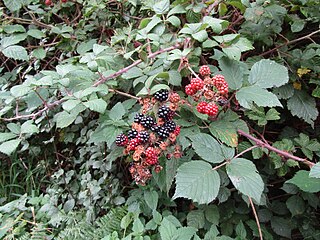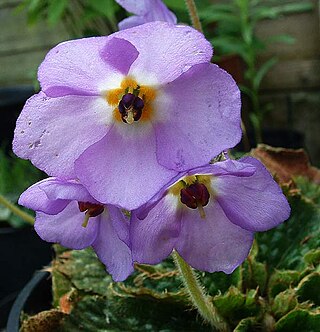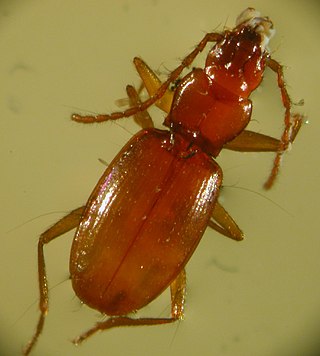
Genus is a taxonomic rank above species and below family as used in the biological classification of living and fossil organisms as well as viruses. In binomial nomenclature, the genus name forms the first part of the binomial species name for each species within the genus.

The lagomorphs are the members of the taxonomic order Lagomorpha, of which there are two living families: the Leporidae and the Ochotonidae (pikas). There are 110 recent species of lagomorph of which 109 are extant, including 10 genera of rabbits, 1 genus of hare and 1 genus of pika. The name of the order is derived from the Ancient Greek lagos + morphē.

Rubus is a large and diverse genus of flowering plants in the rose family, Rosaceae, subfamily Rosoideae, with over 1,350 species, commonly known as brambles.

Geranium is a genus of 422 species of annual, biennial, and perennial plants that are commonly known as geraniums or cranesbills. They are found throughout the temperate regions of the world and the mountains of the tropics, with the greatest diversity in the eastern part of the Mediterranean region.

Syringa is a genus of 12 currently recognized species of flowering woody plants in the olive family or Oleaceae called lilacs. These lilacs are native to woodland and scrub from southeastern Europe to eastern Asia, and widely and commonly cultivated in temperate areas elsewhere.

Penstemon, the beardtongues, is a large genus of roughly 280 species of flowering plants native to North America from northern Canada to Central America. It is the largest genus of flowering plants endemic to North America. As well as being the scientific name, penstemon is also widely used as a common name for all Penstemon species alongside beardtongues.

Hyacinthus is a small genus of bulbous herbs, spring-blooming perennials. They are fragrant flowering plants in the family Asparagaceae, subfamily Scilloideae and are commonly called hyacinths. The genus is native predominantly to the Eastern Mediterranean region from the south of Turkey to the Palestine region, although naturalized more widely.

Begoniaceae is a family of flowering plants with two genera and about 2040 species occurring in the subtropics and tropics of both the New World and Old World. All but one of the species are in the genus Begonia. There have been many recent discoveries of species in the genus Begonia, such as Begonia truncatifolia which is endemic to San Vincente, Palawan. B. truncatifolia is smaller than other species of the genus Begonia and this new species is proposed Critically Endangered by standards set by the IUCN. The only other genus in the family, Hillebrandia, is endemic to the Hawaiian Islands and has a single species. Phylogenetic work supports Hillebrandia as the sister taxon to the rest of the family. The genus Symbegonia was reduced to a section of Begonia in 2003, as molecular phylogenies had shown it to be derived from within that genus. Members of the genus Begonia are well-known and popular houseplants.

The Mymaridae, commonly known as fairyflies or fairy wasps, are a family of chalcidoid wasps found in temperate, subtropical, and tropical regions throughout the world. The family contains around 100 genera with 1,400 species.
Agathiphaga is a genus of moths, known as kauri moths. and is the only living genus in the family Agathiphagidae. This caddisfly-like lineage of primitive moths was first reported by Lionel Jack Dumbleton in 1952, as a new genus of Micropterigidae.

The genus Cathartes includes medium-sized to large carrion-feeding birds in the New World vulture (Cathartidae) family. The three extant species currently classified in this genus occur widely in the Americas. There is one extinct species known from the Quaternary of Cuba.
The Itombwe owl is a species of owl in the barn owl family, Tytonidae. It is restricted to a small area in the Albertine Rift montane forests.

Ramonda serbica, also known as Serbian ramonda and Serbian phoenix flower, is a species in the family Gesneriaceae and are one of the four plants in the Ramonda genus. It was first discovered in 1874 near Niš, Serbia, by the Serbian botanist Josif Pančić. The Serbian ramonda is notable for its distinctive desiccation tolerance.

Pseudanophthalmus is a genus of cave beetle. Over 200 species have been described in the caves of ten states of the eastern United States.

Oroperipatus is a genus of Neotropical velvet worms in the family Peripatidae. Species in this genus are found in South America west of the Andes and in Mexico. This genus is viviparous, with mothers supplying nourishment to their embryos through a placenta.
Platyxythrius is a genus in the ground beetle family Carabidae. There are at least 20 described species in Platyxythrius, found in Africa.
Ameroduvalius jeanneli is a species of beetle in the family Carabidae, the only species in the genus Ameroduvalius.
Darlingtonea is a genus in the ground beetle family Carabidae. This genus has a single species, Darlingtonea kentuckensis. It is found in the United States.

The Solanaceae, or the nightshades, are a family of flowering plants that ranges from annual and perennial herbs to vines, lianas, epiphytes, shrubs, and trees, and includes a number of agricultural crops, medicinal plants, spices, weeds, and ornamentals. Many members of the family contain potent alkaloids, and some are highly toxic, but many—including tomatoes, potatoes, eggplant, bell, and chili peppers—are used as food. The family belongs to the order Solanales, in the asterid group and class Magnoliopsida (dicotyledons). The Solanaceae consists of about 98 genera and some 2,700 species, with a great diversity of habitats, morphology and ecology.

Toxonotus is a genus of fungus weevils in the beetle family Anthribidae. There are about 13 described species in Toxonotus.














